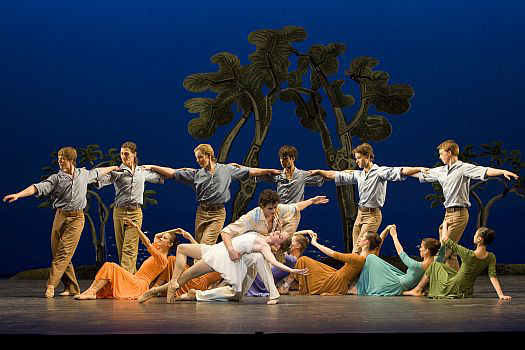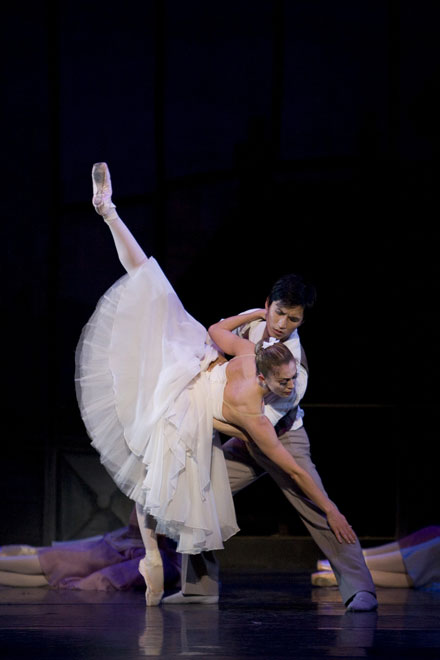 United Kingdom Frederick Ashton ‘Spring Passions’ Double Bill, Daphnis and Chloë and The Two Pigeons: Dancers of the Birmingham Royal Ballet, the Royal Ballet Sinfonia, conducted by Koen Kessels. London Coliseum, London, 13.3.2012. (JPr)
United Kingdom Frederick Ashton ‘Spring Passions’ Double Bill, Daphnis and Chloë and The Two Pigeons: Dancers of the Birmingham Royal Ballet, the Royal Ballet Sinfonia, conducted by Koen Kessels. London Coliseum, London, 13.3.2012. (JPr)
By the time this review is read this double bill – after just three performances – will have taken flight and left London. That is a great shame because essentially for a memorable evening of ballet are (in no particular order) quality choreography, dancing and music, and these were of the highest order in this rare London appearance by Birmingham Royal Ballet. I have been unable to review London’s Royal Ballet recently but I doubt if their orchestra could have played better, or The Two Pigeons, in particular, be better danced.

There is a similarity to the story of both of the ballets because they involve two people in love but who are then parted, with one or the other being mistreated in some way – either by pirates or gypsies – before they are reconciled once more in a romantic dénouement. They are recreated masterpieces from one of Birmingham Royal Ballet’s favourite choreographers, Frederick Ashton. Now over half-a-century old both works were basically new when they were created as the original choreography for the Ballets Russes’ 1912 Daphnis and Chloë had been lost and André Messager’s rediscovered one-act score for The Two Pigeons was completed by John Lanchbery to allow for a return to the opening scene with the lovers reunited in their Bohemian garret. Some minor doubts notwithstanding this was an outstanding evening and Ravel’s music for Daphnis and Chloë must be one of the finest of all ballet scores,. Whilst the music for The Two Pigeons is less ‘original’ it is still absolutely sublime. My appreciation of the exceptional level of musical accompaniment to the dancing (usually the least considered aspect of ballet) is a huge compliment to the strong conducting by Koen Kessels of the Royal Ballet Sinfonia who produced some accomplished playing and ravishing sounds throughout the evening.
Now writing after the fact of course, the opening Daphnis and Chloë seemed a little dated and under-rehearsed but that was because The Two Pigeons was so wonderful. It was the first time I had seen this and the designs are John Craxton’s originals for Ashton’s ballet and he worked on its revival in 2007. The women’s pastel coloured dresses and shirt-sleeved men in trousers mirror the seductive Mediterranean colours in Ravel’s score. The stylised cut-out sets, somewhat redolent of the time of the ballet’s creation, enhance the timeless background to the goings-on. Also the story is very thinly plotted when compared to The Two Pigeons. It did not seem to have Ashton’s most inventive chorography but then again he may well have been paying homage to the Ballets Russes who first staged it. There is some Greek-style line dancing for the shepherds and shepherdesses and almost equal amounts of mime and dance throughout the rest of the hour-long ballet.
The pastoral couple, Daphnis and Chloë, express their love for one another but then face a challenge – in more ways than one – from the young married girl, Lykanion, and the herdsman, Dorkon, who cause trouble since Lykanion has designs on Daphnis, as Dorkon does for Chloë. She is kidnapped by a band of pirates and it needs Pan and his Nymphs to rescue her and restore order. When Pan arrives, complete with cloven hooves and horns, he brings an element of pantomime to the proceedings from which – in my opinion – the ballet never fully recovers.
Elisha Willis had a busy evening and leading roles in both ballets, and was excellent throughout. She is an accomplished actress as well as an elegant dancer and was as charming in her conflicted emotions when pursued by Dorkon as she was affecting in her sad solo with her hands bound in the pirates’ lair. Ambra Vallo caught the eye as the alluring Lykanion and Matthew Lawrence was an impressively brawny Dorkon. Unfortunately, for me, Iain Mackay was a rather straight-backed and stilted Daphnis and I felt little chemistry between him and Willis’s Chloë. In general, it was an excellent ensemble performance but in the smaller roles Tyrone Singleton was a potent pirate chief and Céline Gittens, Victoria Marr and Jenna Roberts in full-body makeup were the poised, otherworldly, Nymphs.

Opening in a Paris artist’s studio, Jacques Dupont’s evocative set – with its window and city skyline – is elegantly lit by Mark Jonathan. The Young Man is trying to paint The Young Girl who apparently has more than sitting for a portrait in mind. Her romantic frustration is mirrored by his annoyance at her inability to sit still, and he yearns to be somewhere else. When a band of gypsies arrive, he is lured away by A Gypsy Girl. Of course as in Carmen, The Gypsy Girl is quickly bored with The Young Man; anyway her actual lover is not happy with the situation and takes it out on The Young Man who is thrown out of the camp, hands bound – another similarity to Daphnis and Chloë. Throughout the ballet, bird-like movements are repeated and even now with his hands bound by ropes The Young man evokes the pigeons of the title when he expresses his sorrow at his plight. He brings a pigeon back to the studio and finds The Young Girl lying on the floor like an injured bird. Their reunion is very tender and there is one of the biggest ‘Ahh’ moments of all ballet evenings as the second pigeon flies in to symbolically pair up again with its ‘mate’.
Thirty years separate this performance of The Two Pigeons from the only other one I have seen which was at Covent Garden and led by the almost incomparable Lesley Collier and David Wall. But the talent of the Birmingham Royal Ballet’s dancers almost eclipses the memory of that performance. Sadly Robert Parker is retiring from performing this year and while we must all accept his decision, it is a shame to see someone with such charisma and talent forsaking the stage forever. Together with Nao Sakuma’s The Young Girl they were an attractive – and very convincing – pair of lovers, both dancing with an ease and fluency that was of the highest order. The gypsies danced fearsomely, with considerable energy and perfect timing; Tzu-Chao Chou was a spirited Gypsy Boy, Elisha Willis was perfectly cast once again as the wilful Gypsy Girl and Matthew Lawrence – who also had a busy evening – smouldered perfectly as her lover.
I urge all ballet lovers to support the work of BRB whether in Birmingham, London or wherever they are performing, as they are a company currently performing at the height of their powers.
Jim Pritchard
Geoff Read’s review of BRB earlier in March also appears on this website.